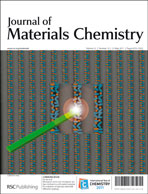Three-dimensional actuators transformed from the programmed two-dimensional structures via bending, twisting and folding mechanisms
Abstract
Combining the physical principle of actuators with the basic concept of photonic crystals, colour-tunable three-dimensional (3D) photonic actuators were successfully fabricated. By controlling the d-spacings and the refractive index contrasts of the self-assembled 3D colloidal photonic crystals, colours of the photonic actuators were tuned. Various shapes of these 3D actuating objects were constructed by transforming the programmed 2D structures via bending, twisting and folding mechanisms. These 2D structures were first programmed by breaking the symmetry. The selective swellings were then applied as driving forces to control the shapes and colours of the photonic actuators. Scroll photonic actuators had been first demonstrated by bending the traditional 2D cantilever structure (K.-U. Jeong, et al., J.Mater.Chem., 2009, 19, 1956). By breaking the symmetry of a cantilever structure perpendicular to its long axis,


 Please wait while we load your content...
Please wait while we load your content...